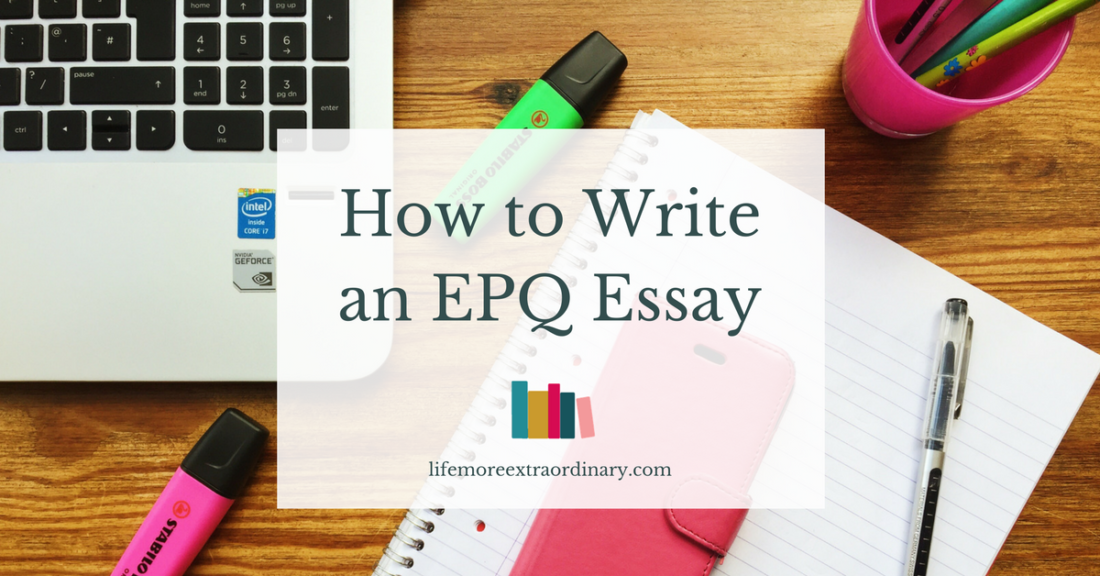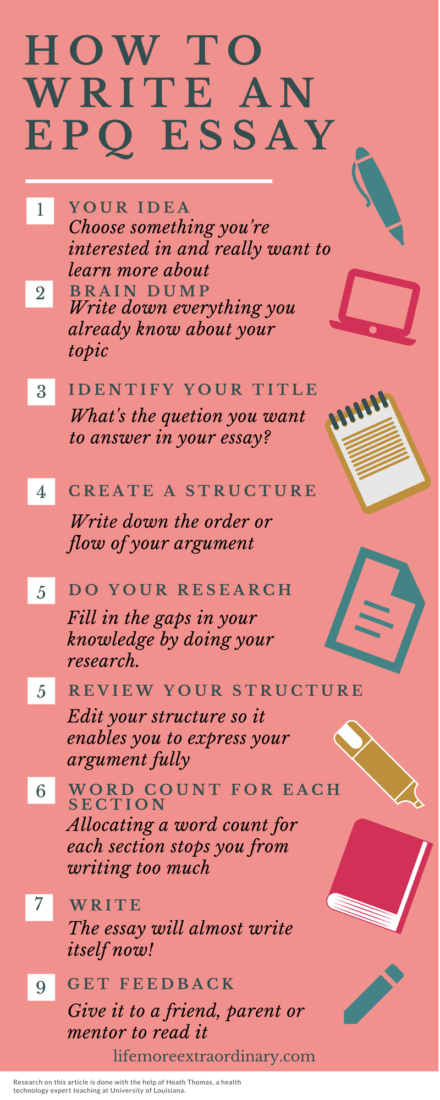How to Write an EPQ essay (including lessons I’ve learned from writing my book)
 I often get emails from my blog readers asking me how to write an EPQ essay. It's a big project and can be quite daunting. However, I think this type of independent academic research is incredibly important in preparing you for the kind of work you'll be expected to do at university.
I often get emails from my blog readers asking me how to write an EPQ essay. It's a big project and can be quite daunting. However, I think this type of independent academic research is incredibly important in preparing you for the kind of work you'll be expected to do at university.
Having just finished re-writing my book, The Ten Step Guide to Acing Every Exam You Ever Take (due to be published in February 2017) I thought now was the perfect time to share the lessons I've learned from doing an extended piece of writing like this so you can apply them to writing your EPQ essay.
How to write an EPQ essay – 9 Steps
1. Your idea
 The first place to start is with an idea. My advice here to is study something that you are genuinely interested in and also really want to learn more about. It's also helpful to study something that furthers your larger aims. So, if you know you're particularly interested in a certain area of the subject that you want to study at university, go deeper into that interest with your EPQ research.
The first place to start is with an idea. My advice here to is study something that you are genuinely interested in and also really want to learn more about. It's also helpful to study something that furthers your larger aims. So, if you know you're particularly interested in a certain area of the subject that you want to study at university, go deeper into that interest with your EPQ research.
I did exactly this with my book. I want to become known as an expert in study skills and exam skills. The perfect way to do this is to write a book about it. Hopefully lots of new people will find me as a result of reading my book and want to work with me. My book is furthering my long-term aims (as well as being something I've always wanted to do – yippee for being a published author!).
2. Brain dump
Once you've come up with an idea brain dump everything you already know about it. This is important because your current knowledge is the foundation of where you're going to go next. It will also enable you to identify the gaps in your knowledge and therefore what further research you need to do.
Believe it or not, over the last eighteen months or so my brain dump has been my blog! As I've listened more and more to my readers to hear what they need help with and what problems they have I have learned more and understood more about the field of study skills. I've researched, thought and read to improve my knowledge and understanding and put all that knowledge into my blog.
3. Identify your title or question
The next step is having some idea of what your title might be or what question you want to answer with your work. Throughout your research you need to ensure that you're finding information that will help you to answer this question.
With my book, the title dictated the structure that the book would take. It helped me to stay focused on what I needed to include as well as exclude.
4. Create a structure for your finished piece
From what you know already and the title you have identified you can create a draft structure or plan for your finished piece of work. Again, this structure will help to keep you focused on what research you need to do to properly answer your question. However, remember that you can always change your structure if what you find in your research deems it necessary.
When I was writing my book I had the overall structure which started with four parts and the ten chapters were divided up between those four parts. When I sat down to write each chapter I wrote a list of what I wanted to include in each of those chapters and decided in what order it was logical and sensible to write about each of those things. Doing this made the actual writing part easy – the book almost wrote itself!
5. Do your research
Now is the time to fill in the gaps in your knowledge by doing your research. Make sure you stay focused on your title and structure all the time that you're doing your research. It's also really important to keep a clear record of where you've gained your information for your references and bibliography. I remember in my early days at university writing endless notes that then got in a muddle and I could never identify the source text which meant I couldn't use that information in an essay because I couldn't reference it. I learned my lesson and soon put a system in place so that I could always identify where my notes, ideas and quotes came from!
With my book my research was listening to my readers and clients and reading books that helped me to solve the problems that they were dealing with. For example, I read a book called ‘Mini Habits' by Stephen Guise – and used that book as the basis for a blog post. I have now incorporated those ideas into the book.
6. Review your structure
As you're doing your research, and particularly once you've finished it, you'll need to review your structure. Your structure is essentially a summary of the argument you want to make in your essay. If the information you've found has lead you to an opinion that you can't express through your original structure then the structure needs to be altered or changed. This is the time when you need to be 100% sure that your structure provides with the framework to say exactly what you want to say in answer to the question or title you have set yourself.
I have found this to be particularly important with my book. The original version of my book was written before I even started my blog. The ten steps I included were all the clearest things I'd learned from my own experience as a student and from teaching geography in schools. However, through my blog, reading and coaching I gained more insights about my own experience and what really helped others. This meant that when I came to re-write the book I had more to say so that I had to change the structure to accomodate all this new understanding and knowledge.
7. Allocate a word count to each section of your structure
You know your essay has to be 5,000 words long and you know which sections you want to put into it because you've planned your structure. To make life easy for yourself you should now allocate a word count to each section. This means that you won't fall into the dreadful trap of writing way too much and having to cull all your hard work to be within the word limit.
I did this for my book. My publisher said that he'd like a 30,000 word book. The original book was about 14,000 words so I had to more than double it. I knew that I had ten basic chapters plus an introduction, foreword and other bits and pieces. So, I set myself the target that each chapter should be approximately 3,000 words. In the end some of the chapters are slightly shorter and others are slightly longer than this but I easily hit the 30,000 word marker by making sure I was reaching the word count for each chapter as I went along.
8. Write
Can you believe we got to number eight before you actually started writing? Well, this is because all the planning and research you've done up until now will make the writing process really, really easy. The essay should almost write itself!
This is what I found with my book. My plan was so detailed and I'd done so much research over the preceeding eighteen month period that the writing bit was just easy. I sat down for between one and two hours a day for just eighteen days and the first draft of the book was written. It was utterly painless. I then spent two weeks reviewing and editing as well as writing the introduction.
9. Get feedback
The final step is to get feedback on your work. Give it to a friend, parent or mentor to read it through and give you some feedback. The more they know about your subject and academic writing the better. Listen carefully to the advice that they give you and incorporate it as best you can into your work.
The first person to read my book after I'd finished it was my editor. She was thrilled with it and said that ‘it reads wonderfully' and that there was very little she had to change. I credit my thorough planning process for this praise. I hope that your thorough planning leads to the same type of praise.
Some useful EPQ resources from the web
This information from The Student Room gives some really useful background information about the EPQ: http://www.thestudentroom.co.uk/wiki/Extended_Project_Qualification
This post from the UCAS student blog helps you with where to start with your EPQ: https://www.ucas.com/connect/blogs/epq-where-start
You can download this essay guide from the TES website: https://www.tes.com/teaching-resource/epq-guide-essay-structure-6359383
If you know of any other really useful EPQ resources then leave a link in the comments below.
Over to you
I hope these tips really help you to write a brilliant EPQ as easily as possible. I've learned how to structure and organise my work in this way through years and years of experience researching, writing, reading and marking essays. Hopefully you won't have so much trial and error!
Leave me a comment below to tell me what you're studying in your EPQ and what challenges you're facing with it at the moment. I'll be sure to reply to every comment.
Get on the wait list!
My book, The Ten Step Guide to Acing Every Exam You Ever Take, will be published by John Catt in February 2017. If you'd like to know when you can pre-order make sure you're on my mailing list – you'll also get a free exert from the book when you sign-up.
